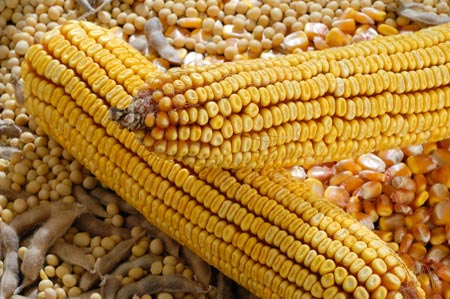 (Agrimoney) – The, unusually weak, pace of US corn and soybean harvesting will pick-up this week, thanks to a break in the weather, potentially renewing pressure on prices – temporarily, at least.
(Agrimoney) – The, unusually weak, pace of US corn and soybean harvesting will pick-up this week, thanks to a break in the weather, potentially renewing pressure on prices – temporarily, at least.
A “drier patter” which moved into the Midwest this weekend “should continue to favour harvest progress early this week, with only minor delays expected from showers in the north western Midwest Wednesday and Thursday”, weather service MDA said.
Heading into next week too, “showers should remain limited across the Midwest and Delta, which will continue to favour corn and soybean harvesting”.
At broker Futures International, Terry Reilly said, “the weather forecast calls for improving US crop progress,” while at RJ O’Brien, also based in Chicago, Richard Feltes flagged an “open and warming Midwest forecast”.
One of the slowest on record
The expectations of an improved harvest pace follow slower-than-expected progress in the week to Sunday, when wet weather again limited fieldwork, meaning farmers gathered in only 13% of their soybean crop, 2 points less than expected.
That took total US soybean harvest progress to 53% so far, compared with an average of 66%, and rendering it the second slowest in the past 20 years, behind only that of 2009, data from the US Department of Agriculture show.
For corn, the harvest advanced by just 7 points, again falling short of expectations, to reach 31% completion, again well short of the 53% of the crop farmers normally have in the barn by now.
In 1995, only harvests in 2008 and 2009 were running slower, with that in 1996 keeping around the same pace.
‘Fieldwork at standstill’
Harvest delays were particularly marked in some of the key Corn Belt states, such as Illinois, where growers have reaped 43% of their corn, 20 points behind the average, and 37% of soybeans, a lag of 29 points.
“Three weeks of wet conditions have left the ground saturated in parts of the state,” USDA scouts said, adding that only “limited harvest of corn and soybeans occurred last week”.
In neighbouring Indiana, where soybean harvest at 31% complete has proceeded at half the normal pace, “frequent rains have continued to prolong fall harvest, making it difficult for farmers to use equipment in the soaked fields”.
In Michigan, where growers are 37 points behind on soybean harvesting and 20 points on corn, “rainy and cold weather continued most of last week, and these conditions put fieldwork at standstill in most regions of the state”, USDA scouts said.
‘Waiting for soils to dry’
The knock-on effects of the tardy harvest include a slow start to winter wheat plantings in affected Corn Belt states – typically growers of soft red winter wheat, as traded in Chicago.
In Illinois, sowings were just 22% completed as of Sunday, compared with an average of 59%, while for Ohio, the top soft red winter wheat grower, plantings were 8 point behind at 55%.
“Wet conditions throughout the state have farmers waiting for soils to dry before harvesting or planting can continue,” USDA scouts in Ohio said.
By contrast, plantings were ahead of the usual pace in states such as Montana, Oklahoma and Oregon not bogged down with row crop harvest, and growers largely of alternative winter wheat varieties, such as white or hard red winter wheat.
Storage squeeze?
However, the slow harvest has provided some compensation to growers in reducing the strain on farmers’ storage capacity, lowering the need for forced crop sales at low prices which prevailed earlier this month.
Indeed, it has allowed demand to mop up large amounts of harvest supplies, with the University of Illinois estimating that some 3.2bn bushels of feed grains, wheat, and soybeans, equivalent to 690.6m bushels a day, were consumed between September 1 and October 16.
“That pace of use continues so that nearly 16% of the total fall crop supply has already been consumed,” said Darrel Good, professor in the university’s department of agricultural and consumer economics.
“That magnitude of consumption has substantially reduced the requirement for crop storage capacity, resulting in a modest strengthening of the corn and soybean basis in many areas.”
Price impacts
Professor Good acknowledged that a” more rapid pace of harvest, particularly for corn, is expected to occur this week and beyond as weather conditions remain favourable over much of the production area”.
This acceleration “would be expected to keep basis levels for corn and soybeans seasonally weak”, basis being the gap between cash and futures prices, and which has a large influence on grain market sentiment.
Nonetheless, “a typical post-harvest recovery in basis levels is expected”, he added.




